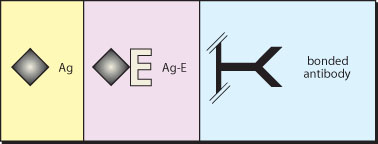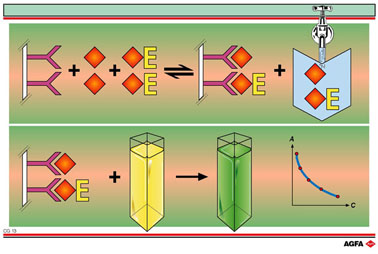CG13 EIA: clinical analysis using enzymes
| Aim:
Application of immunochemistry and enzymology in modern clinical
analytical techniques. |
It is possible to determine low concentrations of compounds in biological fluids using the selectivity of immunological techniques, coupled to enzymatic colour-forming reactions. These EIA (Enzymze Immuno Assays) can be carried out using the competitive ELISA method (among others) described below.
The
method works as follows:
the test substance is called the "antigen" (Ag), the antigen
marked with enzyme is called AgE, and the antibody of this antigen is
called Al.
A known quantity of AgE and an unknown (to be determined) quantity of
unmarked antigen Ag are simultaneously brought into contact with a limited
quantity of antibody, Al, which is bonded to a solid carrier.
AgE and Ag compete to bind to the antibody.
After equilibration the non-bonded antigen is rinsed off.
The enzyme substrate is added, forming a product that can be assayed using
a colourimeter.
Results: much unknown Ag, little AgE binds, so very little coloured product;
little Ag, much AgE binds, much coloured product.
If the colour reaction is calibrated, he concentration can be determined.

